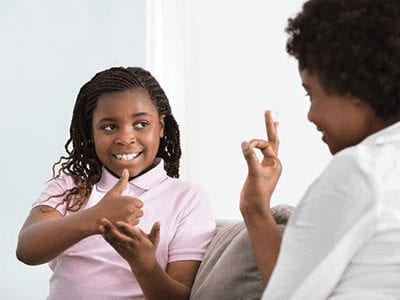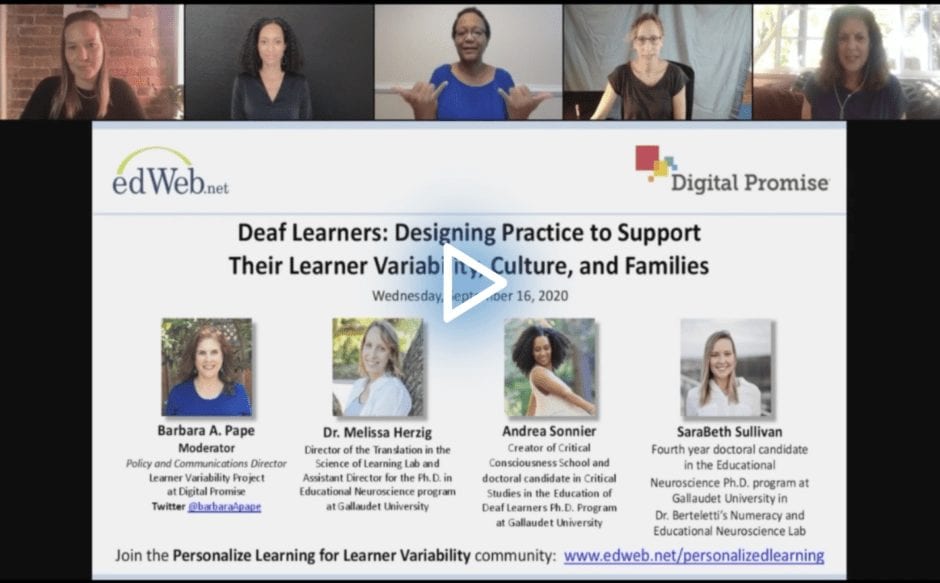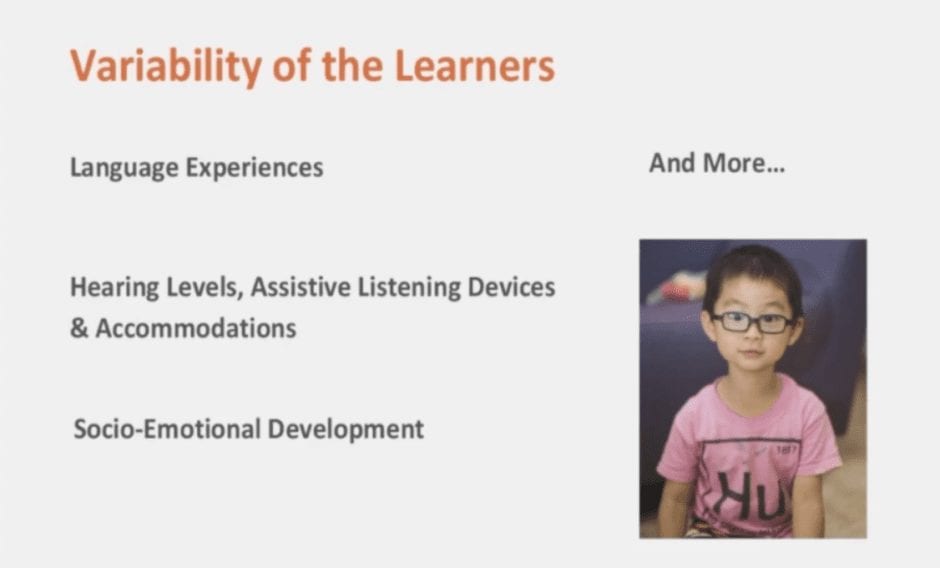Intersectionality and Deaf Learners—One Education Does Not Fit All
By Stacey Pusey
At the beginning of each school year, teachers often take the time to get to know their students—their favorite subjects, their goals, their families, etc. With deaf and hard of hearing learners, though, many educators stop and let that one characteristic define the student and the student-teacher relationship. But in the edWebinar, “Deaf Learners: Designing Practice to Support Their Learner Variability, Culture, and Families,” sponsored by Digital Promise, the presenters explained why educators need to dig deeper and understand all of the factors influencing the student’s motivation and interest in learning.
First, in order to develop an education plan for deaf and hard of hearing students, teachers must learn about the student’s language background. Without understanding the student’s foundation, the teacher won’t be able to develop appropriate lessons. Potential survey questions include:
- Were they born with any level of hearing? What’s their exposure to auditory language?
- At what age did the student start using sign language, if at all? Does anyone sign at home?
- How many languages are used at home? For instance, some families speak Spanish, English, and American Sign Language (ASL).
- What’s the student’s exposure to phonology, both auditory and visual?
Similarly, teachers should know whether or not a student has any residual hearing and the accommodations they use in the classroom. Do they have an interpreter or an assistive device? Does the student prefer captioning? Or for a deaf-blind student, does the teacher understand how tactile ASL works? Again, the point is that each deaf and hard of hearing learner has their own needs and learning styles, so each student must be approached individually.
Further complicating the picture is the student’s and family’s past experiences with schools. Many deaf and hard of hearing students are put in lower tracks automatically, for instance. Thus, the student believes that teachers have low academic expectations, and the student isn’t motivated to learn. Or the parents have had negative encounters with educators who won’t advocate for their child, so they don’t come to open houses or communicate with teachers because the parents don’t expect any results. Teachers need to reach out to parents and have one-on-one conversations with them about their child, their expectations, and how the teachers can help.
As well as being deaf or hard of hearing, the presenters noted that BIPOC students have additional factors to consider. Many have experienced discrimination that goes beyond their hearing status, which gets compounded in the classroom. For instance, just as many regular curricula are Euro-centric, most deaf curricula are modeled for White deaf students and not BIPOC students, which causes a further separation between the student and education.
Once teachers have a better understanding of their student’s home life, language exposure, and past experiences with schooling, there are steps they can take to develop a strong relationship with their deaf and hard of hearing students.
- Like any other student, find out their interests to help personalize their lessons. Create an entry point into the lessons that shows you’ve been listening to the student.
- If the student has a strong relationship with another adult in the school, lean on the relationship until you have time to establish rapport with the student. Find out why the student trusts that adult, why they work well together, etc., and incorporate elements into your approach to the learner.
- Don’t try to fix the student or automatically blame them if they aren’t staying on track. Examine the problem from all angles to see if there is another factor impacting education. Take the time to understand how inequities affect their experience and influence their educational environment.
- Don’t let bias creep into learner expectations. By the time a deaf or hard of hearing student enters your class, they may have encountered racism, sexism, classism, ableism, and other forms of bias that hinder their education. But all students deserve to be challenged, and being deaf or hard of hearing doesn’t change their learning potential.
This edWeb broadcast was sponsored by Digital Promise.
This article was modified and published by eSchool News.
About the Presenters
Dr. Melissa Herzig is the education and research translation manager for VL2, director of the Translation in the Science of Learning Lab, and co-founder and assistant director for Ph.D. in Educational Neuroscience program at Gallaudet University. She is responsible for leading assessments and evaluations of resources within VL2 and for working with schools. Her role is to facilitate two-way communication between researchers and educators. She earned her bachelor’s in biology at Gallaudet University.
Andrea Sonnier devotes her time to teaching and learning from students, families, and professionals involved in the field of deaf education on topics related to social justice. She is currently a doctoral candidate in the Deaf Education Ph.D. program at Gallaudet University. With a focus on K-12 education, Andrea studies issues of educational equity including critical curricula, critical consciousness, praxis, and compassionate practices among teachers and students with multiple intersecting identities.
SaraBeth Sullivan is a third-year doctoral candidate in Educational Neuroscience at Gallaudet University. SaraBeth’s doctoral research explores the neural underpinnings of arithmetic processing in deaf native signers, and she has conducted behavioral, EEG and fMRI studies to further explore this topic. This summer, she was a research intern with Digital Promise, working with the Learner Variability Project. After completing her doctoral degree, she hopes to pursue a career in policy work aimed at improving special education access and standards, as well as advocating for the deaf community to improve access in education.
About the Host
Barbara Pape is the policy and communications director for the Learner Variability Project at Digital Promise. She has 20 years’ experience in strategic communications, writing, and policy analysis, primarily in education. Previously, she served as the executive producer of the award-winning Teaching & Learning conference, sponsored by the National Board for Professional Teaching Standards, where she developed content and oversaw outreach and communications. As a writer, she has written for numerous publications, including Harvard University, the National Education Goals Panel (U.S. Department of Education), and Parents magazine. Barbara also served as editor and publisher of the first electronically delivered education newsletter, the Daily Report Card. She served on the Advisory Board of the Kennedy Center’s Intersection of Arts Education and Special Education Committee, serves as a judge for the Miliken-Penn Graduate School of Education Business Plan competition, and is on the Boards at the Education Writers Association and Potentia. She earned an Ed.M. at Harvard University’s Graduate School of Education and launched her career as a middle school language arts teacher.
Join the Community
Personalize Learning for Learner Variability is a free professional learning community on edWeb.net that brings together researchers, educators, entrepreneurs and product developers to share the latest research findings, best practices, and success stories that are shaping the development of research-based programs and products to address the growth of learning variability in today’s schools.

Stacey Pusey is an education communications consultant and writer. She assists education organizations with content strategy and teaches writing at the college level. Stacey has worked in the preK-12 education world for 20 years, spending time on school management and working for education associations including the AAP PreK-12 Learning Group. Stacey is working with edWeb.net as a marketing communications advisor and writer.





Comments are closed.